With so many companies coming out with more and more affordable smartphones for budget-centric people out there, including myself, looking for a new phone can be a little bit of a daunting task. You’d have to account for decent performing cameras and good battery life. Luckily, the Redmi Note 9 ticks all those boxes (and more), so let’s dive a little deeper and check it out.
.
Table of Contents
It’s good to see that Redmi decided to break-away from the typical water-drop notch look and vertically aligned rear cameras, which are slowly becoming too much a familiar aesthetic.
With a glossy-metallic like finish and a seemingly bezel-less screen, it sure is a step above other mid-range devices out there. We get a generous display size of 6.53-inches, a thickness of 8.9mm, and comes in at a weight of 199 grams, which feels pretty robust. It’s also good to note that it comes with a plastic screen protector pre-installed, so you don’t have to worry about scratching the screen for the first few months. The Redmi Note 9 is available in three different color options: Polar White, Forest Green, and Midnight Grey, which is the unit that we have right now.
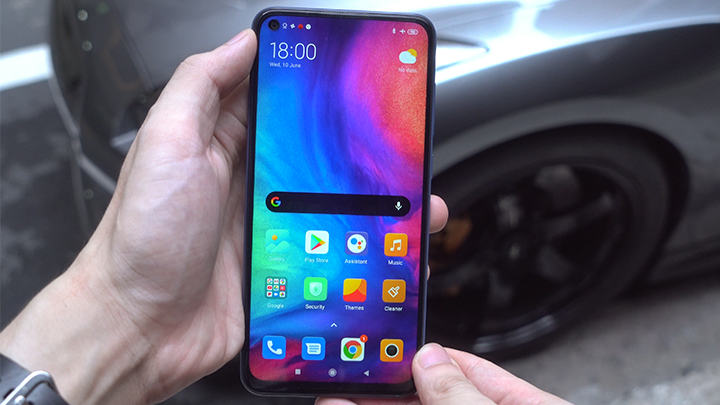
At the front, one of the first things you’ll notice from the Redmi Note 9 is their camera set-up, which finally received an updated punch-hole design that Redmi is calling their DotDisplay. It does have a noticeable bezel by the chin, although I don’t think it’ll be much of a bother for a screen size that big. What does bother me, though, is the lack of a notification light, which I’m sure is something a lot of people would still find useful.
Heading over to the back, we can see where most of the design was poured into with that premium looking metallic finish that still looks quite subtle. Due to its glossy design, it is quite a fingerprint magnet, although it’s good to see that a lot of phone manufacturers like Redmi often include a free jelly case. It’s not just to protect your phone from looking bad, but also helps with better grip and drags less attention when you’re out in public.
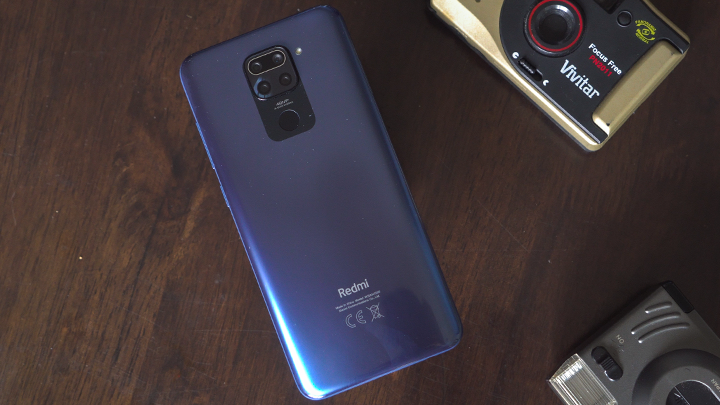
In our previous hands-on article, we did mention that it had a polycarbonate finish, but, upon double-checking on Corning’s official website, it looks like the Redmi Note 9 is also equipped with a Gorilla Glass 5 panel at the rear, which is pretty impressive as the phone’s edges are curved. Another noticeable design element can be found in their rear camera module, which has a rounded square set-up instead of having them vertically aligned.
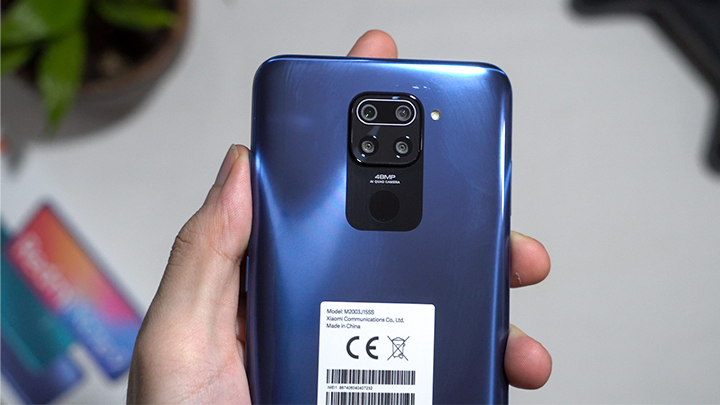
While it still protrudes quite a bit from the rear panel, having the camera at the center means you won’t be getting those annoying wobbles when placing your phone on a flat surface. Below all of that, you can find their rear-mounted fingerprint scanner, which looks very subtle as it’s incorporated along with the camera’s design. At the same time, the LED flash independently sits nicely on the right side.

On the left of the device is your dual nano-SIM card tray coupled with a dedicated MicroSD card slot for expandable storage, while on the right you can find the power button and your standard volume rocker keys.

At the top, we get your signature IR Blaster and the secondary noise-canceling microphone. At the bottom, we have your standard USB-C charging port, single bottom-firing speakers, the primary mic, and a convenient 3.5mm audio jack.
As mentioned, the Redmi Note 9 sports a 6.53-inch Full HD+ IPS display with a resolution of 1080 x 2340, a screen-to-body ratio of 83.5%, and a pixel density of 395ppi. Nothing record breaking here, but as expected, viewing angles were still great with decent color reproduction. We also get a maximum screen brightness of approximately 450 nits, which makes using this device under harsh lighting no problem.

Audio quality performs adequately, which shouldn’t be a surprise for a bottom-firing speaker. If you rely on your phone to play music as you’re taking a shower or if you’re in an average-sized room, the Redmi Note 9 should be more than enough.
Heading over to the quad rear shooter, the top half of the camera module sits a 48MP Samsung GM1 primary sensor and an 8MP ultrawide, while below are the dual 2MP lens for macro shots and another for depth sensing. The camera performance was surprisingly excellent. Shots in default mode were well detailed, although it does tend to be a little oversaturated, especially when shooting in bright environments. When things get a little dimmer, colors do get less vibrant, but turning on Night mode does bring those colors back if not make it even better.

Since the Redmi Note 9 uses the GM1 sensor, we don’t get the actual 48 million pixel resolution, as Samsung’s sensor uses pixel interpolation to convert a 12MP picture into 48MP instead. However, after some downtime in this setting, shots were still impressive, allowing me to zoom in to a decent extent without too much pixelation. Ultrawide mode was a pleasant experience as we retain those beautiful colors with an excellent viewing angle of 118 degrees. The detail might not be as good as the primary camera, but is still nothing short of impressive.
With its updated design coupled with a promising processor and GPU all packed into a familiar interface, this device seems to be the next bang-for-buck choice for those who are currently looking for a reliable and affordable phone.
The front camera is just as great, as the shots were beautiful and vibrant, showing the right amount of detail. Hairs and blemishes were well defined, especially when you have the beauty feature set to natural. And because of the punch-hole camera being on the left corner of the screen, you also might have to adjust a little bit when taking selfies, but other than that, I was pretty satisfied.
When it comes to video, the Redmi Note 9 is capable of recording up to 1080p at 60fps. Colors reproduction is okay in well-lit environments, but it does get a little harder to get decent shots in less favorable lighting conditions. We do get a stabilization feature in the settings menu, which works well, but can still be shaky at times, which is understandable given the caliber of this device. In any case, there is always the option to fix unstable videos via Google photo’s stabilization feature.
The Redmi Note 9 comes with MIUI 11 based on Android 10, which I consider one of my favorite skins. But apart from Google apps, expect some bloatware to take up some of your storage space. By default, there will be some pop-up Ads and suggestions as you navigate around the user interface, which can thankfully be turned off in the settings. And although you can delete some of the pre-installed content, there’s no way of permanently getting rid of MIUI’s native apps, but you can always remedy this by hiding them through a third-party launcher.

Putting that aside, the overall UI is generally the same experience as you would get from previous Redmi Note devices running the same software. We have a system-wide dark mode, Game Turbo, one-handed mode, second-space, and their Mi Share feature, which conveniently lets you transfer files quickly across cross-brands like Oppo and Vivo. And since it comes with a built-in IR blaster, you can also make use of its Remote app, which lets you control things like your TV, Air-conditioning unit, and other IR remote-controlled devices.

Our unit has a storage capacity of 128GB, although there is a more affordable 64GB variant as well. If that’s not enough, you can always expand your storage space up to 512GB through a MicroSD card. As for biometrics, the rear-mounted fingerprint scanner works very well and takes less than a second for you to unlock the device. For an extra layer of security, you can also activate face unlock, which works just as fast, especially in well-lit environments.
The Redmi Note 9 is powered by Mediatek’s latest Helio G85 octa-core processor coupled with a Mali-G52 MC2 GPU that Redmi claims it has a 22% faster CPU and a 33% faster GPU compared to its predecessor (Redmi Note 8). As for memory, this device runs on 4GB of RAM. And although they have a 3GB version, which is cheaper, the 4GB variant will be a better investment in the long-run.
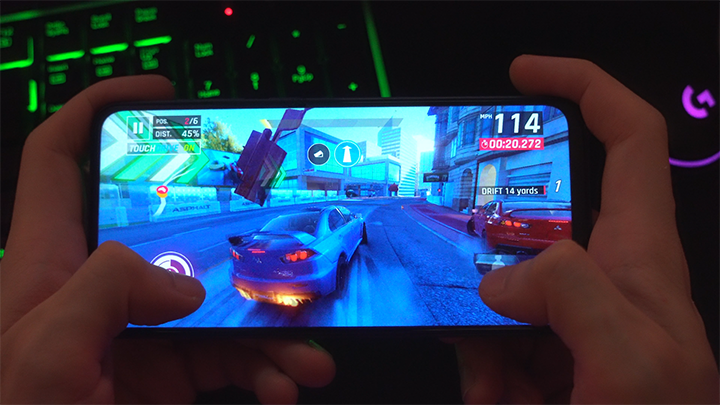
Overall, the Redmi Note 9 was relatively quick and snappy when it came to day to day tasks, although there are times I do run into some minor hiccups, especially when jumping from multiple heavy tasks. When it comes to gaming, the performance was pretty excellent as I didn’t encounter any stuttering in Call of Duty, Mobile Legends, PUBG Mobile, and Asphalt. Although setting the graphics to high does make the phone run quite warm–which is relatively normal.
Putting it through some benchmark tests, the Redmi Note 9 showed some decent results but is far from impressive. To give you a better idea, we got a single-core score of 357 on Geekbench, which is just 23 points higher than the previous Redmi Note 8, while the Note 8 Pro sits at 482 points. Now, these are just basic references for a quick comparison, but when it comes to using the unit, there wasn’t much to complain about. Check out the rest of the scores below:
• AnTuTu V8 – 205,711
• Geekbench 5 – 357 (single-core) 1,320 (multi-core)
• PC Mark – 8,329 (Work 2.0 Performance)
• 3D Mark – 1,368 (OpenGL) 1,384 (Vulcan)
• AndroBench – 317.12 MB/s (Seq. Read) 263.67 MB/s (Req. Write)
One of the highlights of the Redmi Note 9 is it’s massive 5,035 mAh battery capacity, which Redmi touts can last for up to approximately 16 hours of continuous gaming. In our average video loop test (1080p mp4 video on loop, 50% brightness, 50% volume with headphones, and Airplane Mode on), the Redmi Note 9 lasted a total of 11 hours and 21 minutes of playback. While gaming for 16 hours straight was out of the question, it’s safe to assume that this device can last quite a while unplugged, which is great for multimedia consumption or if you just don’t want to carry around your charger all day.
Using the 22.5W power brick and cable that came with the unit, it took roughly 4 hours to get the device up to 100%, which is quite a while compared to a lot of other phones out there, so be sure to charge it before going to bed, so you wake up to a full battery.
With an attractive physical design, above-average camera quality, and good battery life, the Redmi Note 9 is a promising mid-range device that doesn’t skimp out on performance and build quality.
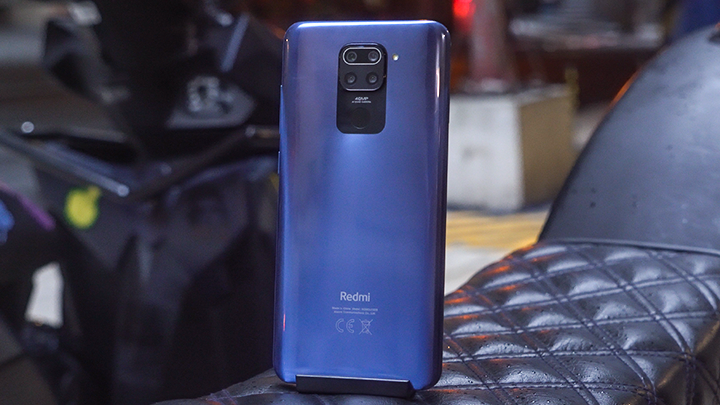
By no means is this a hardware beast, but for what it can offer at a very competitive price point, it’s a pretty good choice for those looking to buy a mid-range class smartphone with an entry-level price.
The Redmi Note 9 is priced at PHP 7,990USD 136INR 11,542EUR 130CNY 992 for the 3GB+64GB variant and PHP 9,990USD 170INR 14,432EUR 162CNY 1,240 for the 4GB+128GB.
Xiaomi Redmi Note 9 specs:
6.53-inch FHD+ (2340 x 1080) DotDisplay
Corning Gorilla Glass 5
MediaTek Helio G85 2.0GHz octa-core CPU
Arm Mali-G52 MC2 GPU
3GB, 4GB RAM
64GB, 128GB storage
microSD up to 512GB (dedicated slot)
Quad rear cameras:
• 48MP F1.79 4-in-1 Super Pixel (main)
• 8MP F2.2 (ultra-wide)
• 2MP F2.4 (macro)
• 2MP F2.4 (depth)
13MP F2.25 front camera
Dual-SIM (nano)
4G LTE
WiFi 802.11 a/b/g/n/ac
Bluetooth 5.0
GPS, A-GPS, GLONASS, Galileo, BDS
NFC (select markets)
IR Blaster
USB Type-C
3.5mm audio jack
1216 X max0.5mm high amplitude ultra-linear speaker
Smart PA 10V
Fingerprint scanner (rear)
MIUI 11 (Android 10)
Splash-proof nano-coating
5,020mAh battery w/ 18W fast charging, w/ 22.5W charger included
162.3 x 77.2 x 8.9 mm
199 g
Forest Green, Polar White, Midnight Grey

YugaTech.com is the largest and longest-running technology site in the Philippines. Originally established in October 2002, the site was transformed into a full-fledged technology platform in 2005.
How to transfer, withdraw money from PayPal to GCash
Prices of Starlink satellite in the Philippines
Install Google GBox to Huawei smartphones
Pag-IBIG MP2 online application
How to check PhilHealth contributions online
How to find your SIM card serial number
Globe, PLDT, Converge, Sky: Unli fiber internet plans compared
10 biggest games in the Google Play Store
LTO periodic medical exam for 10-year licenses
Netflix codes to unlock hidden TV shows, movies
Apple, Asus, Cherry Mobile, Huawei, LG, Nokia, Oppo, Samsung, Sony, Vivo, Xiaomi, Lenovo, Infinix Mobile, Pocophone, Honor, iPhone, OnePlus, Tecno, Realme, HTC, Gionee, Kata, IQ00, Redmi, Razer, CloudFone, Motorola, Panasonic, TCL, Wiko
Best Android smartphones between PHP 20,000 - 25,000
Smartphones under PHP 10,000 in the Philippines
Smartphones under PHP 12K Philippines
Best smartphones for kids under PHP 7,000
Smartphones under PHP 15,000 in the Philippines
Best Android smartphones between PHP 15,000 - 20,000
Smartphones under PHP 20,000 in the Philippines
Most affordable 5G phones in the Philippines under PHP 20K
5G smartphones in the Philippines under PHP 16K
Smartphone pricelist Philippines 2024
Smartphone pricelist Philippines 2023
Smartphone pricelist Philippines 2022
Smartphone pricelist Philippines 2021
Smartphone pricelist Philippines 2020
JohnB says:
Just got this and it’s a bang for the buck phone for me.
Sephiroth says:
Nice review but RN9 isn’t an entry-level device. Mediatek G85 processor is in the mid-range level category. Official Xiaomi presenter and host even said that it’s a mid-range phone. Check this: https://www.youtube.com/watch?v=WsBmXt4xYJQ
Sephiroth says:
Here’s the correct link: https://www.youtube.com/watch?v=CR3YYNc5ZzQ
Sephiroth says:
Xiaomi Redmi Note 9 Launch event in 8 Minutes: https://www.youtube.com/watch?v=KRptEicKF5U
Janshanti says:
Article was very informative
Thanks for articles.